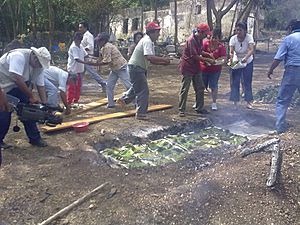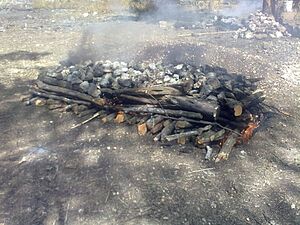Píib facts for kids


A Pib (pronounced peeb) is a special type of earth oven used in the Yucatán Peninsula in Mexico. This cooking method likely started a very long time ago, even before the Spanish arrived. It involves digging a hole, lighting a fire with wood and stones, and then slowly cooking food. The food is usually pork or chicken, and it's all covered with more soil.
Sometimes, people use the word "pib" to talk about tamales cooked in this oven. However, experts say that "píib" really means the oven itself, not the food. A piib oven can cook enough food for up to forty people! This makes it perfect for big parties and local celebrations.
For example, in a town called Kantunilkín, people prepare piib for December 8th. This is a special day for the town's patron saint. They also make other dishes like Relleno negro for Hanal Pixan, which is a Mayan celebration.
Contents
What Does 'Pib' Mean?
In Yucatán, the oven is mostly known as pib or píib. This is how it's spelled in the Mayan language today. Sometimes, it's even shortened to pii. If you want to talk about more than one piib, you say piib'ob, not "pibs." To say "to make a piib," you would use the word piibt.
Food that is cooked in a piib oven is called pibil. Many people think "pibil" means the food has a special red seasoning called recado. But actually, the ending -bil means "roasted" or "buried." So, pib-bil means "roasted [thing]." For example, the famous cochinita pibil (pork cooked in a piib) is called piibi'k'éek'en in Mayan.
A Look Back: The History of Piib
The piib oven isn't clearly described in old Mayan books. But experts believe it was used long before the Spanish came to Mexico. Why? First, earth ovens were not part of Spanish cooking traditions. So, the Spanish couldn't have brought this method with them. Second, other native groups in Mesoamerica also used earth ovens.
You can find other types of earth ovens in different parts of Mexico. For example, there's the ximbó in Hidalgo and the classic Mexican barbecue. But nowhere are earth ovens as common as they are in the Yucatán. Both native people and mestizo people (people of mixed heritage) use them. Farmers often roast a whole lamb in these ovens on Sundays and holidays.
A study in 2012 looked at traditional piib'ob in a town called Xocén, Yucatán. It found that people used local animals and plants to prepare them. This suggests that piib cooking has been going on since before Christopher Columbus arrived. Back then, the earth oven might have been used to keep food fresh, especially after hunting trips that lasted many days.
The study also showed a strong connection between the piib and the kool (Mayan cornfield). Both might be very old, possibly around 3,400 to 3,000 years before common era. Another clue comes from old animal bones found with heat marks, but no cutting marks. This fits with cooking in a piib.
At the ancient site of Palenque in Chiapas, the word pib appears in old writings. It doesn't mean the oven directly, but it has a related meaning. For example, one temple is called u-pibnahil, which means "steam bath temple." Pib'naah means "steam bath."
The oldest written mention of "pib" is in a dictionary from the 1500s. It describes "pib" as a "bath or temazcal" (a type of steam bath) and also as "the stove in which pumpkins, meats, etc. were roasted under the ground." It also meant "roasted meat, squash, etc. under ground."
More recently, in 2019, a chef named Wilson Alonzo led a study on modern piib cooking. He looked at how piib is made in twelve different towns in Yucatán.
How to Make a Piib Oven
Making a piib takes time and effort. The size and shape of the hole depend on how much food you want to cook. Also, the way people make a piib can be different from one area to another.
Digging the Hole
In the western part of the Yucatán, ovens are often square, about 1 meter (3 feet) wide. In the east and south, people dig long, rectangular holes. This is because they line up many large pots inside, sometimes up to a dozen. Along the northern coast, you might find round ovens. Locals say this is because of the strong winds there. The depth of the piib can be from a few centimeters to about 1 meter (3 feet) deep.
The piib is usually prepared the day before it's used. People dig a hole in red soil, which is called K'an kab in Mayan. If you're near the coast, like in Progreso, the hole might be dug in beach sand.
Getting the Fire Ready
To help the fire start faster, some people put dry palm leaves or newspaper at the bottom. In the western area, wood goes under the stones. But in the east, stones go below and wood on top. The wood and stones are carefully stacked in a pyramid shape.
The stones must be solid and strong. They are called si'in túun because they hold heat better. You can check if a stone is solid by tapping it; it should sound hollow. Soft Limestone rocks are not good because they crumble easily. Larger stones are saved for cooking that takes a long time.
For firewood, people use hard woods that burn for a long time. Some common trees are catzín, kitinché, chaká, jabín, or chukum. Sometimes, they use fragrant woods like oak. If the cooking will last many hours, they add both dry and green wood. This helps the charcoal stay hot for longer. The fire is lit, and all the wood is allowed to burn down to hot charcoal.
Cooking the Food
Cooking times vary a lot. A chicken might cook in an hour and a half. But a cochinita pibil can take up to 16 hours! It's a tradition to roast whole animals in the piib. Some foods, like cochinita, are wrapped in banana leaves and placed in a pot. Dry foods can go right on the hot stones. If it's a stew, the pot is placed on the stones.
Some popular dishes cooked in a piib are:
- Piibi'k'éek'en (Mayan) or cochinita pibil (Spanish) – a famous pork dish.
- Pibipollo or mukbil pollo – a large tamale with chicken.
- Relleno negro pibil – a dark, flavorful stew.
- Piibinaal (Mayan) or elote pibil (Spanish) – roasted corn on the cob.
- Píibil k'úum (Mayan) or calabaza pibil (Spanish) – roasted pumpkin.
- Píibilwaaj (Mayan) or tamal pibil (Spanish) – a type of tamale.
- Píibil yuuk (Mayan) or yuk pibil (Spanish) – roasted brocket deer.
- Píibilwech (Mayan) or huech pibil (Spanish) – roasted armadillo.
There are many kinds of tamales (waaj) cooked in the piib. These include chachak waaj, piibil waaj, and noj waaj. People sometimes mistakenly call these tamales "pib."
After the food is placed, the piib is covered with wild leaves. These leaves, called le', help to trap the steam inside. Different types of leaves can be used, like jabín or pixoy. Banana peels can also be used as a lid. However, banana leaves are not good for covering because they can catch fire. Using aromatic leaves adds new flavors to the food. The amount of leaves used depends on the season. In the rainy season, more wood is used and less cover. In the dry season, it's the opposite. More leaves mean more steam. On rainy days, it's important to prepare the oven the day before to dry the ground.
Special Traditions with Piib
During Hanal Pixan (Mayan Day of the Dead), food from the piib is offered to the spirits of loved ones. After the holidays, the piib hole is cleaned. A cross made of banana leaves and special sipiche leaves is placed over it. Then, it's blessed with water. The ritual ends by closing the hole and saying a prayer.
According to tradition, not everyone can cook a piib. People called sis-k'aab (meaning 'cold hands') are not allowed to get close. If they try to help, the piib might get ruined! People who cook the piib are called j-piib if they are a man, or x-piib if they are a woman.
Images for kids
-
Burying the pibipollos, in Campeche.
-
Chachak waaj (pibil tamale) fresh out of the piib for Hanal Pixan (Mayan Day of the Dead)
See also
 In Spanish: Píib para niños
In Spanish: Píib para niños









